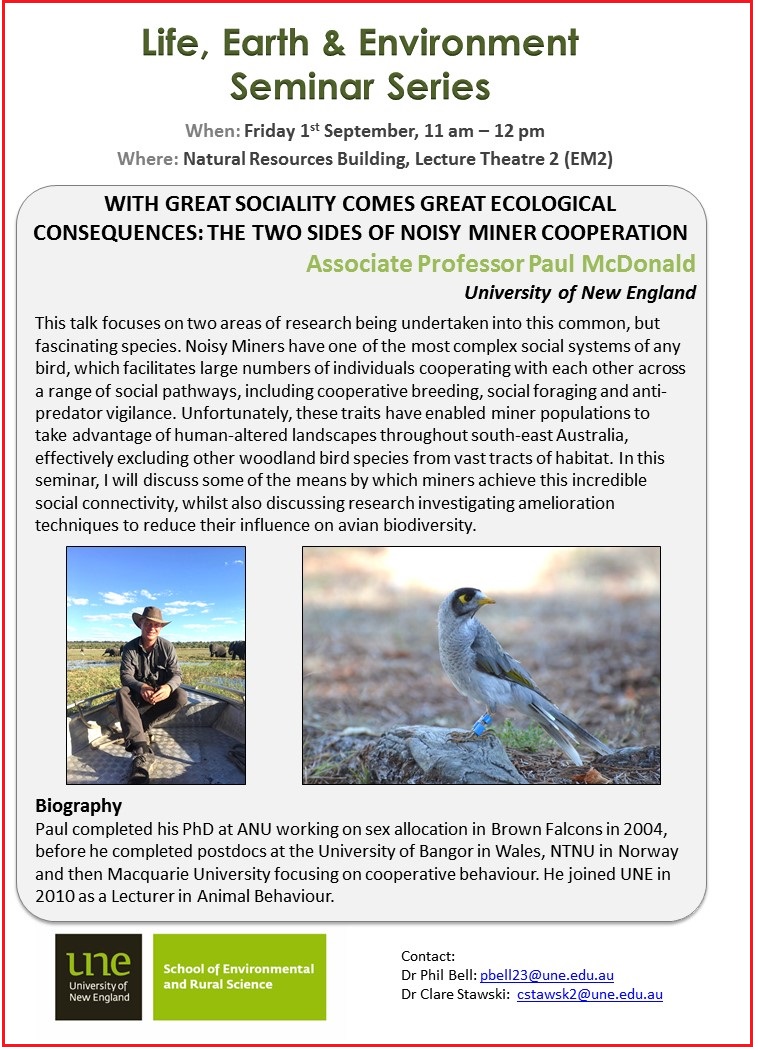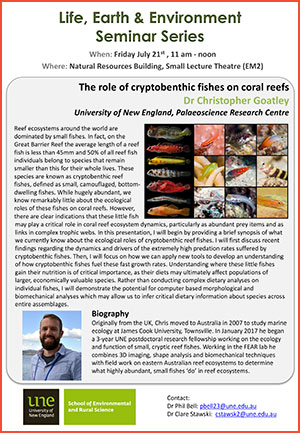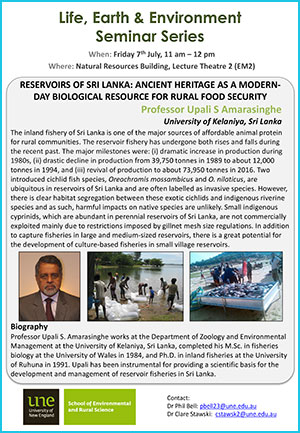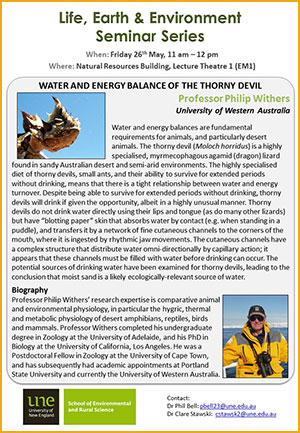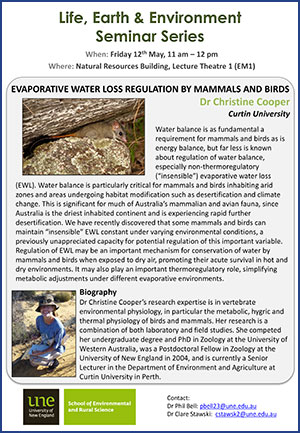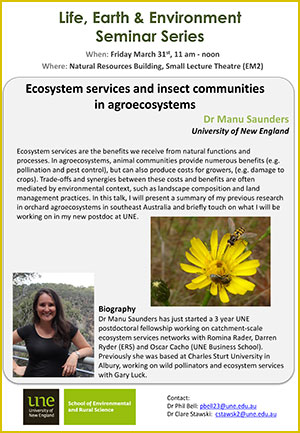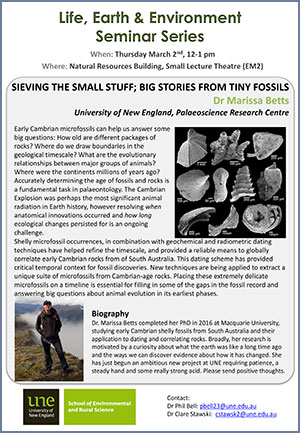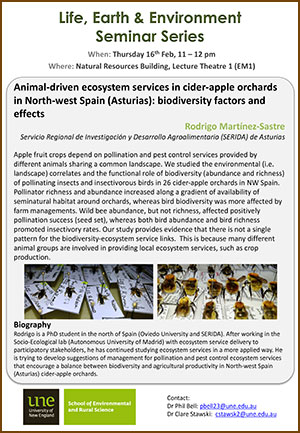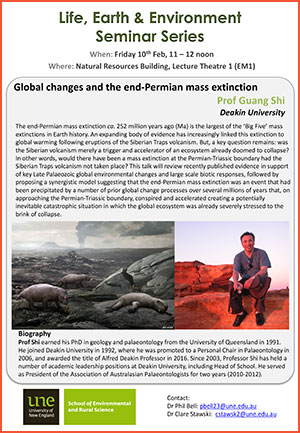2017 Seminar Series
Friday 1st September, 2017. This talk focuses on two areas of research being undertaken into this common, but fascinating species. Noisy Miners have one of the most complex social systems of any bird, which facilitates large numbers of individuals cooperating with each other across a range of social pathways, including cooperative breeding, social foraging and anti-predator vigilance. Unfortunately, these traits have enabled miner populations to take advantage of human-altered landscapes throughout south-east Australia, effectively excluding other woodland bird species from vast tracts of habitat. In this seminar, I will discuss some of the means by which miners achieve this incredible social connectivity, whilst also discussing research investigating amelioration techniques to reduce their influence on avian biodiversity. Biography Paul completed his PhD at ANU working on sex allocation in Brown Falcons in 2004, before he completed postdocs at the University of Bangor in Wales, NTNU in Norway and then Macquarie University focusing on cooperative behaviour. He joined UNE in 2010 as a Lecturer in Animal Behaviour. Friday 21st July, 2017. Reef ecosystems around the world are dominated by small fishes. In fact, on the Great Barrier Reef the average length of a reef fish is less than 45mm and 50% of all reef fish individuals belong to species that remain smaller than this for their whole lives. These species are known as cryptobenthic reef fishes, defined as small, camouflaged, bottom-dwelling fishes. While hugely abundant, we know remarkably little about the ecological roles of these fishes on coral reefs. However, there are clear indications that these little fish may play a critical role in coral reef ecosystem dynamics, particularly as abundant prey items and as links in complex trophic webs. In this presentation, I will begin by providing a brief synopsis of what we currently know about the ecological roles of cryptobenthic reef fishes. I will first discuss recent findings regarding the dynamics and drivers of the extremely high predation rates suffered by cryptobenthic fishes. Then, I will focus on how we can apply new tools to develop an understanding of how cryptobenthic fishes fuel these fast growth rates. Understanding where these little fishes gain their nutrition is of critical importance, as their diets may ultimately affect populations of larger, economically valuable species. Rather than conducting complex dietary analyses on individual fishes, I will demonstrate the potential for computer based morphological and biomechanical analyses which may allow us to infer critical dietary information about species across entire assemblages. Biography Originally from the UK, Chris moved to Australia in 2007 to study marine ecology at James Cook University, Townsville. In January 2017 he began a 3-year UNE postdoctoral research fellowship working on the ecology and function of small, cryptic reef fishes. Working in the FEAR lab he combines 3D imaging, shape analysis and biomechanical techniques with field work on eastern Australian reef ecosystems to determine what highly abundant, small fishes ‘do’ in reef ecosystems. Friday 7th July, 2017. The inland fishery of Sri Lanka is one of the major sources of affordable animal protein for rural communities. The reservoir fishery has undergone both rises and falls during the recent past. The major milestones were: (i) dramatic increase in production during 1980s, (ii) drastic decline in production from 39,750 tonnes in 1989 to about 12,000 tonnes in 1994, and (iii) revival of production to about 73,950 tonnes in 2016. Two introduced cichlid fish species, Oreochromis mossambicus and O. niloticus, are ubiquitous in reservoirs of Sri Lanka and are often labelled as invasive species. However, there is clear habitat segregation between these exotic cichlids and indigenous riverine species and as such, harmful impacts on native species are unlikely. Small indigenous cyprinids, which are abundant in perennial reservoirs of Sri Lanka, are not commercially exploited mainly due to restrictions imposed by gillnet mesh size regulations. In addition to capture fisheries in large and medium-sized reservoirs, there is a great potential for the development of culture-based fisheries in small village reservoirs. Biography Professor Upali S. Amarasinghe works at the Department of Zoology and Environmental Management at the University of Kelaniya, Sri Lanka, completed his M.Sc. in fisheries biology at the University of Wales in 1984, and Ph.D. in inland fisheries at the University of Ruhuna in 1991. Upali has been instrumental for providing a scientific basis for the development and management of reservoir fisheries in Sri Lanka. Friday 26th May, 2017. Water and energy balances are fundamental requirements for animals, and particularly desert animals. The thorny devil (Molochhorridus) is a highly specialised, myrmecophagous agamid (dragon) lizard found in sandy Australian desert and semi-arid environments. The highly specialised diet of thorny devils, small ants, and their ability to survive for extended periods without drinking, means that there is a tight relationship between water and energy turnover. Despite being able to survive for extended periods without drinking, thorny devils will drink if given the opportunity, albeit in a highly unusual manner. Thorny devils do not drink water directly using their lips and tongue (as do many other lizards) but have “blotting paper” skin that absorbs water by contact (e.g. when standing in a puddle), and transfers it by a network of fine cutaneous channels to the corners of the mouth, where it is ingested by rhythmic jaw movements. The cutaneous channels have a complex structure that distribute water omni-directionally by capillary action; it appears that these channels must be filled with water before drinking can occur. The potential sources of drinking water have been examined for thorny devils, leading to the conclusion that moist sand is a likely ecologically-relevant source of water. Biography Professor Philip Withers’ research expertise is comparative animal and environmental physiology, in particular the hygric, thermal and metabolic physiology of desert amphibians, reptiles, birds and mammals. Professor Withers completed his undergraduate degree in Zoology at the University of Adelaide, and his PhD in Biology at the University of California, Los Angeles. He was a Postdoctoral Fellow in Zoology at the University of Cape Town, and has subsequently had academic appointments at Portland State University and currently the University of Western Australia. Friday 12th May, 2017. Water balance is as fundamental a requirement for mammals and birds as is energy balance, but far less is known about regulation of water balance, especially non-thermoregulatory (“insensible”) evaporative water loss (EWL). Water balance is particularly critical for mammals and birds inhabiting arid zones and areas undergoing habitat modification such as desertification and climate change. This is significant for much of Australia’s mammalian and avian fauna, since Australia is the driest inhabited continent and is experiencing rapid further desertification. We have recently discovered that some mammals and birds can maintain “insensible” EWL constant under varying environmental conditions, a previously unappreciated capacity for potential regulation of this important variable. Regulation of EWL may be an important mechanism for conservation of water by mammals and birds when exposed to dry air, promoting their acute survival in hot and dry environments. It may also play an important thermoregulatory role, simplifying metabolic adjustments under different evaporative environments. Biography Dr Christine Cooper's research expertise is in vertebrate environmental physiology, in particular the metabolic, hygric and thermal physiology of birds and mammals. Her research is a combination of both laboratory and field studies. She competed her undergraduate degree and PhD in Zoology at the University of Western Australia, was a Postdoctoral Fellow in Zoology at the University of New England in 2004, and is currently a Senior Lecturer in the Department of Environment and Agriculture at Curtin University in Perth. Friday 31st March, 2017. Ecosystem services are the benefits we receive from natural functions and processes. In agroecosystems, animal communities provide numerous benefits (e.g. pollination and pest control), but can also produce costs for growers, (e.g. damage to crops). Trade-offs and synergies between these costs and benefits are often mediated by environmental context, such as landscape composition and land management practices. In this talk, I will present a summary of my previous research in orchard agroecosystems in southeast Australia and briefly touch on what I will be working on in my new postdoc at UNE. Biography Dr Manu Saunders has just started a 3 year UNE postdoctoral fellowship working on catchment-scale ecosystem services networks with Romina Rader, Darren Ryder (ERS) and Oscar Cacho (UNE Business School). Previously she was based at Charles Sturt University in Albury, working on wild pollinators and ecosystem services with Gary Luck. Thursday 2nd March, 2017. Early Cambrian microfossils can help us answer some big questions: How old are different packages of rocks? Where do we draw boundaries in the geological timescale? What are the evolutionary relationships between major groups of animals? Where were the continents millions of years ago? Accurately determining the age of fossils and rocks is a fundamental task in palaeontology. The Cambrian Explosion was perhaps the most significant animal radiation in Earth history, however resolving when anatomical innovations occurred and how long ecological changes persisted for is an ongoing challenge. Shelly microfossil occurrences, in combination with geochemical and radiometric dating techniques have helped refine the timescale, and provided a reliable means to globally correlate early Cambrian rocks from of South Australia. This dating scheme has provided critical temporal context for fossil discoveries. New techniques are being applied to extract a unique suite of microfossils from Cambrian-age rocks. Placing these extremely delicate microfossils on a timeline is essential for filling in some of the gaps in the fossil record and answering big questions about animal evolution in its earliest phases. Biography Dr. Marissa Betts completed her PhD in 2016 at Macquarie University, studying early Cambrian shelly fossils from South Australia and their application to dating and correlating rocks. Broadly, her research is motivated by a curiosity about what the earth was like a long time ago and the ways we can discover evidence about how it has changed. She has just begun an ambitious new project at UNE requiring patience, a steady hand and some really strong acid. Please send positive thoughts. Thursday 16th February, 2017. Apple fruit crops depend on pollination and pest control services provided by different animals sharing a common landscape. We studied the environmental (i.e. landscape) correlates and the functional role of biodiversity (abundance and richness) of pollinating insects and insectivorous birds in 26 cider-apple orchards in NW Spain. Pollinator richness and abundance increased along a gradient of availability of seminatural habitat around orchards, whereas bird biodiversity was more affected by farm managements. Wild bee abundance, but not richness, affected positively pollination success (seed set), whereas both bird abundance and bird richness promoted insectivory rates. Our study provides evidence that there is not a single pattern for the biodiversity-ecosystem service links. This is because many different animal groups are involved in providing local ecosystem services, such as crop production. Biography Rodrigo is a PhD student in the north of Spain (Oviedo University and SERIDA). After working in the Socio-Ecological lab (Autonomous University of Madrid) with ecosystem service delivery to participatory stakeholders, he has continued studying ecosystem services in a more applied way. He is trying to develop suggestions of management for pollination and pest control ecosystem services that encourage a balance between biodiversity and agricultural productivity in North-west Spain (Asturias) cider-apple orchards. Friday 10th February, 2017. The end-Permian mass extinction ca. 252 million years ago (Ma) is the largest of the ‘Big Five’ mass extinctions in Earth history. An expanding body of evidence has increasingly linked this extinction to global warming following eruptions of the Siberian Traps volcanism. But, a key question remains: was the Siberian volcanism merely a trigger and accelerator of an ecosystem already doomed to collapse? In other words, would there have been a mass extinction at the Permian-Triassic boundary had the Siberian Traps volcanism not taken place? This talk will review recently published evidence in support of key Late Palaeozoic global environmental changes and large scale biotic responses, followed by proposing a synergistic model suggesting that the end-Permian mass extinction was an event that had been precipitated by a number of prior global change processes over several millions of years that, on approaching the Permian-Triassic boundary, conspired and accelerated creating a potentially inevitable catastrophic situation in which the global ecosystem was already severely stressed to the brink of collapse. Biography Prof Shi earned his PhD in geology and palaeontology from the University of Queensland in 1991. He joined Deakin University in 1992, where he was promoted to a Personal Chair in Palaeontology in 2006, and awarded the title of Alfred Deakin Professor in 2016. Since 2003, Professor Shi has held a number of academic leadership positions at Deakin University, including Head of School. He served as President of the Association of Australasian Palaeontologists for two years (2010-2012).